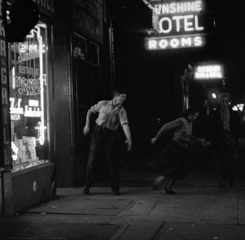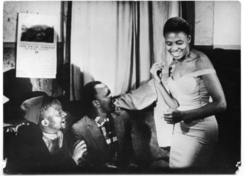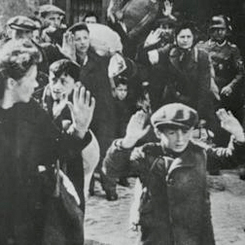Fact Maverick: Three Films From Lionel Rogosin

Fact Maverick: Three Films From Lionel Rogosin
APRIL 29–MAY 12, FRIDAY–THURSDAY
“To tell the truth as you see it incidentally is not necessarily the truth. To tell the truth as someone else sees it is to me much more important and enlightening. Some documentaries are fantastic. Like Lionel Rogosin’s pictures, for instance; like On The Bowery. This guy—who’s probably the greatest documentary filmmaker of all time, in my opinion—he doesn’t care about what anyone thinks, the Cahiers du Cinema crowd, the underground, or anyone else.” —John Cassavetes
Long before the current wave of documentary fiction hybrids infiltrated international film production, New York-based Lionel Rogosin was charting his way through the nether-regions of this genre in-between. His films, all of which reflect a highly personal vision, include On the Bowery (1956), which showcased the harsh reality of life on New York's skid row and was nominated for an Academy Award; Come Back, Africa (1960), decades ahead of its time in its focus on the horrors of apartheid, was named to Time magazine's list of the top ten pictures of the year; and Good Times, Wonderful Times (1968), an effective anti-war documentary, timely in its release during the Vietnam War.
Rogosin’s style, influenced by Flaherty and the Italian neo-realists, complemented the mantras of the New American Cinema movement pioneered by Jonas Meekas. Refusing to work within Hollywood’s accepted boundaries, his independent films had tighter budget restrictions but more artistic freedom that enabled him to ignore clichéd conventions. His first film, On the Bowery, pioneered a production method that would come to dominate his work. For that film he combined a loose fictional plot with documentary footage shot on location in New York’s skid row. Instead of using professional actors, his cast consisted of amateur actors whose lives correlated with those of their fictional characters.
"Making On the Bowery taught me a method of molding reality into a form that could touch the imagination of others," said Rogosin. "The total reality of a community or a society is so vast that any attempt to detail its entirety would result in nothing more than a meaningless catalogue of stale, factual representation—a result which I call ‘documentary.’ Flaherty’s great work has no more to do with ‘documentary’ than great poetry has to do with the factual report of a sociologist."
Rogosin was also owner of the Bleeker Street Cinema in New York's Greenwich Village, during a time when the theater showcased some of the finest works being produced in cinema. Said Rogosin, speaking to the New York Times after the purchase, “There is a dearth of houses for certain kinds of pictures—the sort that may not be commercial, precisely, but ones which do deserve to be seen." The sentiment is unfortunately all the more true today.
It is our great pleasure to be able to share three of Rogosin’s films, two in new 35mm prints! His cinema and its influence have touched many of the films we’ve shared in the last few years, including Lisandro Alonso, Miguel Gomes, C.W. Winter and the Safdie Brothers, to name a few. It will likely continue to touch many more in the years to come.
Series pass $12/Film Forum members, $20/general

On The Bowery
New 35mm Print!
55th Anniversary
Apr 29 - May 05, 2011
(Lionel Rogosin, USA, 1956, 35mm, 65 min)
Lionel Rogosin began his influential filmmaking career with this glimpse of life on one of New York’s most downtrodden strips of real estate. At the time the Bowery was a skid row for alcoholics, mostly men of the laboring trades. From the shadows of the extinct Third Avenue El and the smoky half-light of bars where pocket change would send patrons reeling into days, weeks, lifetimes of oblivion, Rogosin delivers a piece as visually captivating as it is anthropologically essential.
"SW Pick: The ultimate New York movie...living history captured with such fortune and care that there's no sign of decay after 50-plus years." —Seattle Weekly
"The granddaddy of American independent film...The sooner you see it, the sooner you will be able to go back and watch it a second time." —Seattle Post Globe

Come Back, Africa
New 35mm Print!
May 06 - May 12, 2011
(Lionel Rogosin, USA, 1960, 35mm, 90 min)
Combining documentary and fiction elements, and filmed clandestinely in the streets of Johannesburg, Come Back Africa creates an intimate portrait of the inhuman and violent Apartheid system. The film follows an itinerant Zulu family (including the debut of African singer Miriam Makeba) struggling to survive the quotidian racist indignities of life in the big city slums. A raw, immediate and excoriating political exposé, the film allies its outrage with narrative poignancy to produce an early, influential instance of the hybrid "docudrama" format.
"An invaluable document of life in a South African township in the late 1950’s. The street scenes are marvelous, with do-wop groups performing Elvis Presley songs while police keep a sharp eye out for some infraction of the law so they can break up the merriment. There are many scenes that allow the people to be themselves, and on these occasions the audiences becomes a privileged eavesdropper on a world about which little was known." —Seattle Post Globe

Good Times, Wonderful Times
May 06 - May 08, 2011
(Lionel Rogosin, Great Britain/USA, 1966, DigiBeta, 73 min)
With profound humanity and striking images, Rogosin’s third film may be considered a pivotal work in his filmmaking. Inspired by a deep sense of the danger of nuclear annihilation and the horrors of war, Rogosin traveled the world to gather rare footage in the early 1960s. Brilliantly contrasting these images in all their brute power with a posh dinner party in London, it is a powerful orchestration of moral issues that leaves each viewer face to face with his own responsibilities.
"This is Rogosin’s masterpiece, a radical piece of cinematic decoupage that implicates the attendees of a posh London cocktail party in a century of slaughter." —Seattle Post Globe


